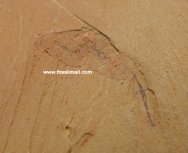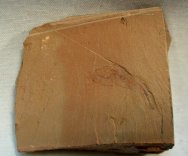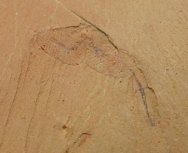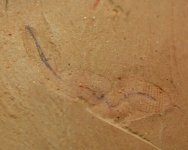| Name:
Priapulida; Corynetis brevis
Geological
Time: Early Cambrian (~525 million years ago)
Size (25.4mm=1
inch): 24 mm long (if straightened) on a 37 mm by 30 mm matrix
Fossil
Site: Chengjiang Biota - Quiongzhusi Section, Yu’anshan Member,
Heilinpu Formation, Mafang, Anning, Kunming, Yunnan Province, China
 Description:
This is an example of the priapulid worm Corynetis brevis. The species
is known from very few specimens, with the taxon named after, Maotianshan
(Mao Tian Hill), site of the discovery of the Chengjiang Biota by
Hou Xian-guang in 1984. The intestine is often preserved as a dark
film, indicative of its deposit-feeding lifestyle. The diversity of
soft-tissue fossils is astonishing: algae, medusiforms, sponges, priapulids,
annelid-like worms, echinoderms, arthropods (including trilobites),
hemichordates, chordates, and the first agnathan fish make up just
a small fraction of the total. Numerous problematic forms are known
as well, some of which may have represented failed attempts at diversity
that did not persist to the present day. The species derives its name
from its small size; this one is the largest I have seen to date.
The fine example preserved here in exquisite detail makes this a highly
unique specimen of life from 525 million years ago. Description:
This is an example of the priapulid worm Corynetis brevis. The species
is known from very few specimens, with the taxon named after, Maotianshan
(Mao Tian Hill), site of the discovery of the Chengjiang Biota by
Hou Xian-guang in 1984. The intestine is often preserved as a dark
film, indicative of its deposit-feeding lifestyle. The diversity of
soft-tissue fossils is astonishing: algae, medusiforms, sponges, priapulids,
annelid-like worms, echinoderms, arthropods (including trilobites),
hemichordates, chordates, and the first agnathan fish make up just
a small fraction of the total. Numerous problematic forms are known
as well, some of which may have represented failed attempts at diversity
that did not persist to the present day. The species derives its name
from its small size; this one is the largest I have seen to date.
The fine example preserved here in exquisite detail makes this a highly
unique specimen of life from 525 million years ago. |
|



